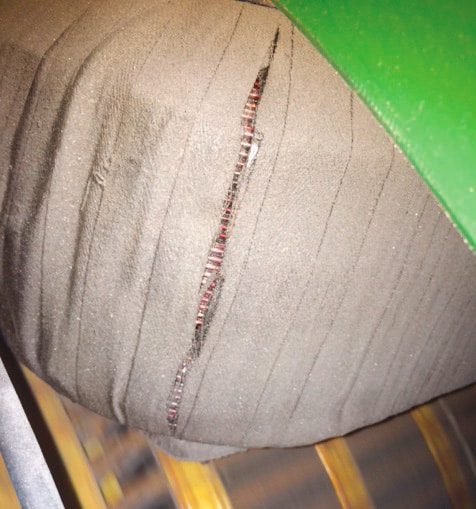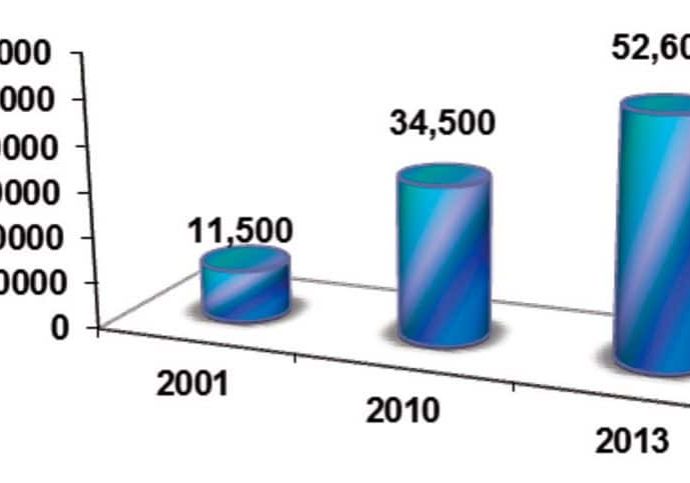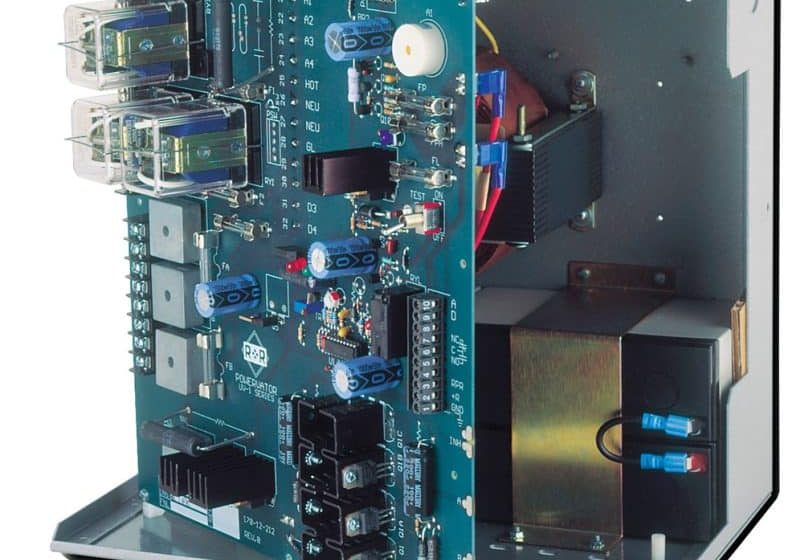The Hidden Details of Modernization
Sep 1, 2014

Many modern elevators have been in service since the 1980s. Due to continued building codes with grandfather clauses (which discourage a sense of the need to modernize), most still use antiquated motors and control technologies. It is not even surprising to find an elevator that has been in use since the 1960s with little or no modernization. Comparatively, the mechanical parts of these systems have been in service longer than most cars have been on the road, and, in the case of high-occupancy buildings, make hundreds of thousands of round trips per year. These days, it is less a question of why or when to modernize an elevator, but simply how to make sure that the modernization process is done properly to ensure future costs are kept to a minimum.
The modernization of an elevator can involve many different parts and functions. Older motors can be upgraded to more efficient ones with encoders and feedback systems, and new relays and other controllers can be added, improving energy, efficiency and speed control. These upgrades require entire systems to be retuned for energy use and efficiency. Even aesthetic items (such as door mechanisms and interiors) that are upgraded can have a dramatic effect on a system’s performance due to changes in weight and its distribution.
The choice to modernize an elevator is normally a business decision, rather than a technical one. For most owners/operators, the decision is strictly financial. The simple cost to modernize an elevator is significant. Before a modernization project is embarked upon, this cost must be justified through a cost-benefit analysis and predetermined rates of return on the investment. In the case of class-A commercial buildings, for instance, the need to upgrade is often to keep up with the competition to attract and keep tenants. In older residential buildings, modernizations are driven from breakdowns not covered under standard maintenance contracts. A common misconception is that energy savings drive the modernization. While there are some savings, unless the local government body is offering rebates when upgraded, these are negligible.
One of the repercussions of modernizing an elevator in the U.S. is that any “alteration” of an elevator requires the entire system to be upgraded to the current ASME A17.1 code. This code, published every three years with annual updates, is enforced by many states and most major cities as the backbone of elevator and escalator codes. A simple motor modernization could require the upgrading of the entire control system under ASME A17.1 or even the interior of the cabs if new Americans with Disabilities Act regulations require modification(s). In some cases, the fire-control system must be fully upgraded. In a class-A commercial office building, this could run into the hundreds of thousands of U.S. dollars.
To define:
- A maintenance plan contains the process for routine examinations of the system. It entails the lubrication, cleaning, and adjustment of parts and subsystems to maintain code compliance.
- A repair of an elevator part is the reconditioning or renewal of that part, component or subsystem in order to keep equipment in full compliance with applicable code requirements, without adding additional capabilities.
- A replacement is the swapping of a component or subsystem with another that is basically the same as the original to ensure proper performance in accordance with applicable code requirements.
Modernization is the replacement of a device or subsystem with new characteristics, controls, features or functions. This is usually labeled as an “alteration” with mandatory requirements to meet new codes.
Creating a Modernization Plan
Modernization consists of upgrading the parts of an elevator necessary to handle newer technology, improving safety, and increasing performance and efficiency. Modernizations can affect control equipment, software, motors, hoists, electrical systems and cab fixtures. Depending on key factors, general costs for modernization can run between US$100,000 for a five-story traction elevator to more than US$250,000 for each unit on class-A buildings.
To control costs, it is critical to create a plan prior to beginning any work. This plan is created with the assistance of an elevator service company, one that will most likely be involved in the heavy work of the modernization. A good plan determines which parts of the elevator are to be modernized and to what extent the procedure will be taken. During this time, it is important to research building codes that might be impacted by the construction and to determine how the process will maintain compliances. A complete plan takes into account not only the mechanical and electrical alterations required for the job, but also the impact of the modernization on passenger flow and other systems within the building, such as heating, ventilation and air-conditioning (HVAC) and power draw. The current state of maintenance of the elevators should also be included.
It will be easier to determine quantifiable benefits from the project if complete maintenance records have been kept prior to the modernization. These benefits include metrics on floor-to-floor travel times, mechanical vibrations, noise levels, door response (open and close) times and passenger response times. The longer the records are kept prior to the modernization, the better they can be in determining how the modernization will affect elevator performance. In any case, modernization or not, these metrics should always be kept, as they can be used to determine if an elevator failure is a unique event or part of a systemic condition.
One fundamental reason for a modernization plan is to help the elevator’s owners/operators avoid surprises and mitigate future costs before they occur. It also assists the building’s owners/operators in understanding the role of modernization in the maintenance, repair, and replacement of the parts of an elevator. It is important to know if an elevator truly needs modernization (as opposed to the simple replacement or repair of a part), as this opens up many new expenses. Age of the system will be key to answering these questions as parts become harder to find for older systems.
Modernization Issues
Two of the most important systems to consider when modernizing an elevator are the control system (hardware and software) and the motors themselves. If either of these is upgraded improperly, it will not only harm them but can harm other electrical and mechanical systems elsewhere in the building through power noise and other disruptions.
Controllers
Elevator control technology has made huge advancements since even the 1990s. Dispatching algorithms that “learn” the traffic patterns of individual buildings are now in use. By analyzing traffic flow, these microprocessors predict how and where to deploy cabs in larger buildings to maximize energy efficiency and rider volume. Multi-car systems no longer work independently, but interdependently. Elevators are no longer sent to levels where another elevator has just made a delivery to pick up passengers who just boarded the recently vacated cab. Such system-level control allows elevators to show up faster on highly populated levels and appear to move faster between levels. With improved acceleration and deceleration rates, aided by faster opening and closing doors or the skipping of levels on the way to the destination (instead of stopping and picking every call up en route), the system transports higher volumes of passengers more efficiently. More advanced control systems can transfer excess energy into storage systems or back into the power grid, instead of bleeding it off as heat, requiring additional HVAC power control. This energy is now recovered in regenerative elevator drives, storing excess energy from one trip to another as electricity (instead of wasting it as heat).
Electrical Issues
Building electrical issues must also be considered when modernizing an elevator. Some standby generators are not compatible with solid-state drives. In addition, newer systems transfer power differently, and it is vital to ensure that a building’s electrical infrastructure can handle the loads, both in amplitude and frequency. In some instances, this can be handled with transfer and pre-transfer switches being installed. A competent elevator-modernization company will design an elevator system with the existing power feeds and load capability taken into account. This should allow for a minimum of change from an electrical standpoint. Often all that is needed when this occurs are new disconnects and piping to the new transformers, filters and controllers.
Motors
Modernization of the motors within an elevator system, among the least visible, can bring about the greatest failures if performed improperly. One of the greatest technological advances in elevator drives in the last century was the development of highly efficient AC induction motors. DC motors were used in the early 20th century, as they had higher starting torques with fewer voltage transients and had better variable speed control. Achieving the same responses with an AC motor required external autotransformers. These, however, made the motors costlier and more complex to run. DC motors still exist in elevators today, as they have been grandfathered into the designs. It is easier/cheaper to replace similar motor types than to do the necessary modernizations required when switching over to an AC motor. However, DC motors must maintain driveline voltages to keep the motors spinning, even with no demand on the line. Allowing an AC motor to shut down when not in use translates into considerable savings for a building. Energy rebates are commonly available for these types of motor upgrades, as the controllers use less energy.
An AC induction motor not only improves energy efficiency, but also improves ride quality. A motor-generator-based drive design can be replaced by a variable-voltage, variable-frequency (VVVF) drive. This type of drive provides near seamless acceleration and deceleration. However, when an AC motor is improperly installed, it will cause terrific damage to the system through AC harmonics, long lead effects with over-voltages, and motor-bearing currents that will cause motors to fail prematurely.
AC harmonics are filtered out with diode bridges and other rectifier circuits for small motors and consumer appliances. However, when a large proportion of energy usage is from VVVF drives, the units can create large harmonics relative to the total load in a building. This negatively impacts the quality of the AC waveform available elsewhere on the same grid. When this waveform becomes distorted due to harmonics, it causes other electronics to incur higher energy losses in the form of heat. When consumer appliances or other motors are forced to draw more power (hence, creating more heat), they begin to decrease in efficiency and, eventually, fail prematurely. In the end, the power company itself is affected by these harmonics, as the resonance conditions begin to damage transformers and capacitors. To mitigate this effect, many power companies require the owners of VVVF drives to install filtering equipment to reduce harmonics below a limit acceptable for other users.
Another drawback of VVVF drives is their inability to overcome the aforementioned long lead effects. A long lead effect is caused in high-voltage transmission lines in which there is a change in impedance within the system, such as when the power cable is connected to a motor. The impedance of the motor terminals acts as a barrier to some of the voltage waveform, reflecting back a part of the waveform. This type of energy reflection, when added to the incoming waveforms, can cause an overvoltage within the lines. This puts high stresses on the cable and windings. Over longer leads, this overvoltage is amplified, causing voltage to reach two or three times the nominal. This issue is controllable with proper filtering and leads lengths, but, if left alone, it will destroy the motors and burn out cables.
The high frequencies of VVVF drives may also cause trouble with motor bearings and windings if improperly controlled. If these high-frequency voltages find a path to earth through a motor bearing, it can spark and erode material through an electrical discharge machining (EDM) effect. Also known as spark machining, spark eroding, burning, die sinking, wire burning or wire erosion, EDM is used in manufacturing to obtain a desired shape using electrical discharges (sparks). Such effects in motors, however, will damage both the bearing’s ball and its race. Motors with poorly grounded equipment are highly susceptible to this type of damage. To prevent an EDM effect, it is important to use good cabling and grounding practices, and properly filter common mode currents. Good cabling means the use of shielding, symmetrical power geometries and installation of shaft-grounded brushes, as well as the use of conductive bearing greases to avoid stray discharges. Motor windings needs to be carefully inspected prior to installation of the new controller to ensure they are capable of handling the VVVF drive frequencies that can prematurely lead to coil failure. A complete survey of the motors should be conducted by a reputable motor shop to help determine which motors are in need of repair or replacement of coils prior to returning the elevator to service.
Conclusion
The modernization of an elevator can come in many forms, from simple aesthetic upgrades to the installation of completely new mechanical and electrical systems. When determining how to execute an elevator modernization, the first thing to do is to research the current state of the elevator and write up a complete modernization plan. In this way, many unnecessary costs can be avoided. Benefits include immediate cost reductions (by determining what can be left “as is”) and unseen future costs by avoiding the costly mistakes of improper motor and electrical installations.
It is also important to collaborate with a reliable and efficient installation company. Creative thinking should be prioritized to determine how an immediate modernization could adversely affect the entire building space in the future.

The cracks in this machine’s coil insulation can easily be overlooked, as replacement costs thousands of U.S. dollars. 
The cracks in this machine’s coil insulation can easily be overlooked, as replacement costs thousands of U.S. dollars. 
(l-r) A controller upgrade, from single-phase Otis MRVF equipment of 1980s vintage to an SRA (AC traction) machine with power-line regenerative kit from SmartRise Engineering, Inc. (photos by Capitol Elevator) 
A gearless unit being serviced 
(l-r) Gearless field coils before refurbishment and after, installed on shoe coils
Get more of Elevator World. Sign up for our free e-newsletter.









